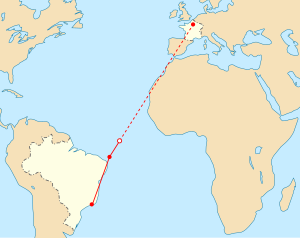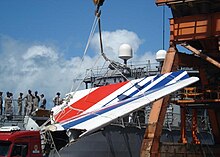Really?
Accident[edit]
 Rio de Janeiro
Rio de Janeiro
22:03, 31 May
Fernando de Noronha
01:33, 1 June
Last known position
N2.98 W30.59
02:10, 1 June
Paris
Expected at 09:10,
1 June

Approximate
flight path of AF 447: The solid red line shows the actual route. The dashed line indicates the
planned route beginning with the position of the last transmission heard. All times are
UTC.
The aircraft departed from
Rio de Janeiro–Galeão International Airport on 31 May 2009 at 19:29 Brazilian Standard Time (22:29 UTC),
[3]: 21 with a scheduled arrival at
Paris-Charles de Gaulle Airport at 11:03 Central European Summer Time (09:03 UTC) the following day (estimated flight time of 10:34).
[57] Voice contact with the aircraft was lost around 01:35 UTC, 3 hours and 6 minutes after departure. The last message reported that the aircraft had passed
waypoint INTOL (
1°21′39″S 32°49′53″W), located 565 km (351 mi; 305 nmi) off
Natal, on
Brazil's north-eastern coast.
[58] The aircraft left Brazilian Atlantic radar surveillance at 01:49 UTC,
[3]: 49
[59] and entered a communication dead zone.
[30][3][
failed verification]
The Airbus A330 is designed to be flown by two pilots, but the 13-hour "duty time" (the total flight duration, as well as preflight preparation) required for the Rio-Paris route exceeded the 10 hours permitted before a pilot had to take a break as dictated by Air France's procedures. To comply with these procedures, Flight 447 was crewed by three pilots: a captain and two first officers.
[60] With three pilots on board, each pilot could take a break in the A330's rest cabin, located behind the ****pit.
[61]
In accordance with common practice, Captain Dubois sent one of the co-pilots for the first rest period with the intention of taking the second break himself.
[62] At 01:55 UTC, he woke up First Officer Robert and said, "... he's going to take my place". After attending the briefing between the two co-pilots, the captain left the ****pit to rest at 02:01:46 UTC. At 02:06 UTC, the pilot warned the cabin crew that they were about to enter an area of turbulence. About two to three minutes later, the aircraft encountered
icing conditions. The
****pit voice recorder (CVR) recorded sounds akin to hail or
graupel on the outside of the aircraft, and
ice crystals began to accumulate in the
pitot tubes, which measure airspeed.
[63] The other first officer, Bonin, turned the aircraft slightly to the left and decreased its speed from
Mach 0.82 to 0.80, which was the recommended speed to penetrate turbulence. The
engine anti-ice system was also turned on.
[64]

The aircraft's
vertical stabilizer after its recovery from the ocean
At 02:10:05 UTC, the autopilot disengaged, most likely because the pitot tubes had icing, and the aircraft transitioned from "
normal law" to "
alternate law 2".
[65] The engines'
autothrust systems disengaged three seconds later. Bonin took manual control of the aircraft, using the command language, "I have the controls." Without the autopilot, turbulence caused the aircraft to start to roll to the right, and Bonin reacted by deflecting his side-stick to the left. One consequence of the change to alternate law was an increase in the aircraft's sensitivity to roll, and the pilot overcorrected. During the next 30 seconds, the aircraft rolled alternately left and right as he adjusted to the altered handling characteristics of the aircraft.
[66] At the same time, he abruptly pulled back on his side-stick, raising the nose. This action was unnecessary and excessive under the circumstances.
[67] The aircraft's
stall warning briefly sounded twice because the angle-of-attack tolerance was exceeded, and the aircraft's indicated airspeed dropped sharply from 274 knots (507 km/h; 315 mph) to 52 knots (96 km/h; 60 mph). The aircraft's
angle of attack increased, and the aircraft subsequently began to climb above its cruising altitude of 35,000 ft (FL350). During this ascent, the aircraft attained vertical speeds well in excess of the typical rate of climb for the Airbus A330, which usually ascend at rates no greater than 2000 feet per minute (10 m/s). The aircraft experienced a peak vertical speed close to 7,000 feet per minute (36 m/s; 130 km/h),
[66] which occurred as Bonin brought the rolling movements under control.
At 02:10:34 UTC, after displaying incorrectly for half a minute, the left-side instruments recorded a sharp rise in airspeed to 223 knots (413 km/h; 257 mph), as did the
integrated standby instrument system (ISIS) 33 seconds later.
[68] The right-side instruments were not recorded by the flight data recorder. The icing event had lasted for just over a minute,
[69][70][3]: 198
[71] yet Bonin continued to make nose-up inputs. The trimmable horizontal stabilizer (THS) moved from 3 to 13° nose-up in about one minute, and remained in the latter position until the end of the flight.
At 02:11:10 UTC, the aircraft had climbed to its maximum altitude around 38,000 feet (11,582 m). At this point, the aircraft's angle of attack was 16°, and the engine thrust levers were in the fully forward
takeoff/go-around (TOGA) detent. As the aircraft began to descend, the angle of attack rapidly increased toward 30°. A second consequence of the reconfiguration into alternate law was that the stall protection no longer operated, whereas in normal law, the aircraft's flight-management computers would have acted to prevent such a high angle of attack.
[72] The wings lost
lift and the aircraft began to
stall.
[4][
page needed]
Confused, Bonin exclaimed, "[Expletive] I don't have control of the airplane any more now", and two seconds later, "I don't have control of the airplane at all!"
[29] Robert responded to this by saying, "controls to the left", and took over control of the aircraft.
[73][32] He pushed his side-stick forward to lower the nose and recover from the stall; however, Bonin was still pulling his side-stick back. The inputs
cancelled each other out and triggered an aural "dual input" warning.
At 02:11:40 UTC, Captain Dubois re-entered the ****pit after being summoned by Robert. Noticing the various alarms going off, he asked the two crew members, "er what are you (doing)?"
[32] The angle of attack had then reached 40°, and the aircraft had descended to 35,000 feet (10,668 m) with the engines running at almost 100%
N1 (the rotational speed of the front intake fan, which delivers most of a
turbofan engine's thrust). The stall warnings stopped, as all airspeed indications were now considered invalid by the aircraft's computer because of the high angle of attack.
[74] The aircraft had its nose above the horizon, but was descending steeply.
Roughly 20 seconds later, at 02:12 UTC, Bonin decreased the aircraft's
pitch slightly. Airspeed indications became valid, and the stall warning sounded again; it then sounded intermittently for the remaining duration of the flight, stopping only when the pilots increased the aircraft's nose-up pitch. From there until the end of the flight, the angle of attack never dropped below 35°. From the time the aircraft stalled until its impact with the ocean, the engines were primarily developing either 100% N1 or TOGA thrust, though they were briefly spooled down to about 50 percent N1 on two occasions. The engines always responded to commands and were developing in excess of 100 percent N1 when the flight ended. Robert responded to Dubois by saying, "We've lost all control of the aeroplane, we don’t understand anything, we've tried everything".
[32] Soon after this, Robert said to himself, "climb" four consecutive times. Bonin heard this and replied, "But I've been at maximum nose-up for a while!" When Captain Dubois heard this, he realized Bonin was causing the stall, and shouted, "No no no, don't climb! No No No!"
[75][32]
When Robert heard this, he told Bonin to give him control of the airplane.
[3] In response to this, Bonin temporarily gave the controls to Robert.
[32][75][3] Robert pushed his side-stick forward to try to regain lift for the airplane to climb out of the stall. However, the aircraft was too low to recover from the stall. Shortly thereafter, the
ground proximity warning system sounded an alarm, warning the crew about the aircraft's imminent crash with the ocean. In response, Bonin (without informing his colleagues) pulled his side-stick all the way back again,
[32][3] and said, "[Expletive] We're going to crash! This can't be true. But what's happening?"
[75][32][3][76][29] The last recording on the CVR was Dubois saying, "(ten) degrees pitch attitude."
The flight data recorders stopped recording at 02:14:28 UTC, 3 hours and 45 minutes after takeoff. At that point, the aircraft's ground speed was recorded as 107 knots (198 km/h; 123 mph), and that the aircraft was descending at 10,912 feet per minute (55.43 m/s) (108 knots (200 km/h; 124 mph) of vertical speed). Its pitch was 16.2° nose-up, with a roll angle of 5.3° to the left. During its descent, the aircraft had turned more than 180° to the right to a compass heading of 270°. The aircraft remained stalled during its entire 3-minute-30-second descent from 38,000 feet (12,000 m).
[77] The aircraft struck the ocean belly-first at a speed of 152 knots (282 km/h; 175 mph), comprising vertical and horizontal components of 108 knots (200 km/h; 124 mph) and 107 knots (198 km/h; 123 mph), respectively. All 228 passengers and crew on board died on impact from extreme trauma and the aircraft was destroyed.
[78][3][76]













